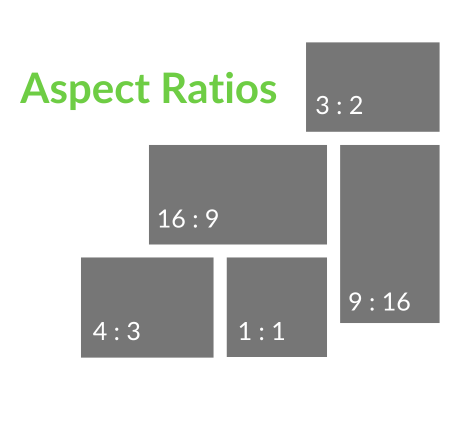When planning an LCD or DVLED video wall , one of the most crucial factors to consider is the aspect ratio. The aspect ratio of a screen defines its shape and proportions, impacting how your content is displayed and perceived. In this blog post, we will demystify aspect ratios, explaining what they are, why they matter, and how to choose the right one for your digital signage needs.
What is an Aspect Ratio?
Aspect ratio is the proportional relationship between the width and height of a screen. It is usually expressed as two numbers separated by a colon, such as 16:9 or 4:3. These numbers represent the width and height units of the display.
16:9 means the screen is in a landscape orientation and 16 units wide for every 9 units of height. (The majority of the single panel landscape screens on our website have a 16:9 aspect ratio). This most common aspect ratio for modern displays, including televisions, computer monitors, and digital signage screens.
Advantages:
- Provides a wide viewing area.
- Supports high-definition content (HD, Full HD, 4K).
- Ideal for video content and dynamic displays.
- Ideal for menu screens, presentation screens, public information displays.
9:16 means the screen is in a portrait orientation and 9 units wide for every 16 units of height. (essentially a 16:9 screen rotated 90 degrees) As an example our Hanging Double Sided Displays have a 9:16 aspect ratio.
Advantages:
- Perfect for displaying mobile-friendly content.
- Grabs attention with a unique format.
- Ideal for tall windows displays
58:9 means the screen is 58 units wide for every 9 units of height. (Check out our 76" Ultra Wide Stretched Display for a very unique display)
Why does the aspect ratio matter when planning an installation?
With DV-LED installations, we can create seamless large-scale video walls to fill spaces of any shape and size in any location. The unique cabinet size gives us the ultimate flexibility by ensuring a 16:9 aspect ratio is also possible. eg. 4 DV-LED cabinets wide x 3 cabinets high will give us a 16:9 aspect ratio. So will a installation which is 8 cabinets wide x 6 cabinets high.
Content Compatibility
Different aspect ratios can affect how your content is displayed. Choosing the right ratio ensures your content looks its best without distortion or letterboxing (black bars) down the side of the screen.
Audience Engagement
A well-chosen aspect ratio enhances viewer experience and engagement. For example, a widescreen (16:9) can make video content more immersive, while a vertical screen (9:16) is ideal for social media content that people are used to seeing on their smartphones.
Aesthetic Appeal
The aspect ratio contributes to the overall aesthetic of your display setup. A sleek, widescreen display might fit a modern retail environment, whereas a traditional 4:3 might suit a classic-themed exhibit.
How to Choose the Right Aspect Ratio
Assess Your Content
Analyse the type of content you plan to display. Video-heavy content typically benefits from a 16:9 ratio, while text-heavy or square-format content might suit a 4:3 screen.
Consider Your Space
Evaluate the physical space where the signage will be installed. Wide areas might benefit from a 21:9 screen, while narrow, vertical spaces could be perfect for a 9:16 display.
Think About Your Audience
Understand your audience’s viewing habits. If your target audience is used to consuming content on widescreen TVs and monitors, a 16:9 ratio will feel familiar and engaging.
Plan for Flexibility
If your content and use cases are diverse, consider screens that can easily rotate between landscape (16:9) and portrait (9:16) orientations.
Choosing the right aspect ratio for your digital signage screen is essential for ensuring that your content is displayed effectively and engagingly. By understanding the different aspect ratios and their respective advantages, you can make an informed decision that best suits your content, space, and audience. Remember, the right aspect ratio not only enhances the visual appeal but also significantly impacts the effectiveness of your digital signage strategy.

